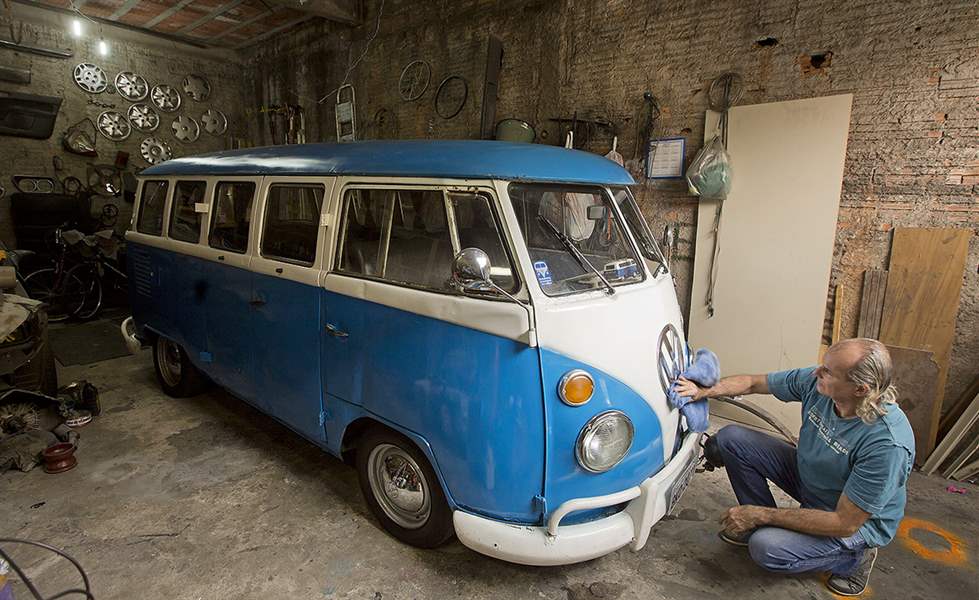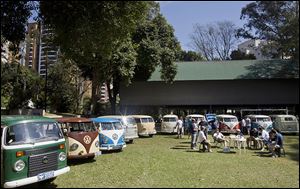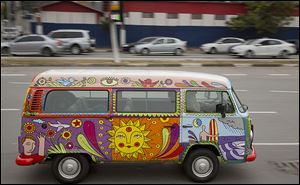
LONG, STRANGE TRIP ENDING
Volkswagen van, hippie icon, to cease production in Brazil
9/24/2013
Enio Guarnieri wipes the emblem of his 1972 Volkswagen van in Sao Paulo. Guarnieri bought the van, or ‘Kombi,’ a year ago. When he was 10, his father taught him to drive a Kombi. ‘Driving a Kombi with your face up against the windshield is a thrilling adventure,’ he said. ‘There is no other van like it.’
ASSOCIATED PRESS

Enio Guarnieri wipes the emblem of his 1972 Volkswagen van in Sao Paulo. Guarnieri bought the van, or ‘Kombi,’ a year ago. When he was 10, his father taught him to drive a Kombi. ‘Driving a Kombi with your face up against the windshield is a thrilling adventure,’ he said. ‘There is no other van like it.’
SAO PAULO — It carried hippies through the 1960s, hauled surfers in search of killer waves during endless summers, and serves as a workhorse across the developing world, but the long, strange trip of the Volkswagen van is ending.

Members of the Sampa Kombi club, a group of Volkswagen van owners, gather for their monthly meeting in Sao Paulo. Brazil is the last place in the world still producing the vehicle.
Brazil is the last place in the world still producing the iconic vehicle, or “bus” as it’s known by aficionados, but VW says production will end Dec. 31. Safety regulations mandate that every vehicle in Brazil must have air bags and anti-lock braking systems starting in 2014, and the company says it cannot change production to meet the law.
Although output will halt in Brazil, there should be plenty of VW vans rolling along for decades if only because there are so many, and they are so durable. VW has produced more than 10 million Volkswagen Transporter vans globally since the model was introduced 63 years ago in Germany, though not all resemble the classic hippie machine. More than 1.5 million have been produced in Brazil since 1957.
The VW van is so embedded in popular culture, it will likely live on even longer in the imagination.
“The van represents freedom,” said Damon Ristau, the Missoula, Mont., director of the documentary The Bus, which follows van fanatics. “It has a magic and charm lacking in other vehicles. It’s about the open road, about bringing smiles to peoples’ faces when they see an old VW van rolling along.”
Perhaps nothing with a motor has driven itself deeper into American and European pop culture than the VW, known for its durability but also its tendency to break down. Van lovers say its failures only reinforce its charm: Because its engine is so simple, it’s easy to fix, imparting a deeper sense of ownership.
The van made an appearance on Bob Dylan and Beach Boys record album covers, among many, though in music circles it’s most closely linked to the Grateful Dead and the legion of touring fans that followed the rock group across the United States, the machines serving as rolling homes. Steve Jobs is said to have sold his van in the 1970s to buy a circuit board as he built a computer that helped launch Apple. The vehicle is linked to the California surf scene, its cavernous interior perfect for hauling boards.

Advertising executive Marcelo Serpa drives his Volkswagen van, emblazoned with a ‘rolling mural’ that he painted, through the streets of Sao Paulo.
But in poorer regions like Latin American and Africa, the vehicle doesn’t carry the same romantic appeal.
It’s used in Brazil by the postal service to haul mail, by the army to transport soldiers, and by morticians to carry corpses. It serves as a school bus for kids, operates as a group taxi, and delivers construction materials to work sites.
Brazilians convert their vans into rolling food carts, setting up on street corners for working-class lunchtime crowds.
A VW plant in Mexico stopped producing the classic version of the van in 1995, though it continued to make its engines for another six years.
That left a factory on Sao Paulo’s outskirts as its last lifeline. Production in Germany was halted in 1979 because the van no longer met European safety requirements.